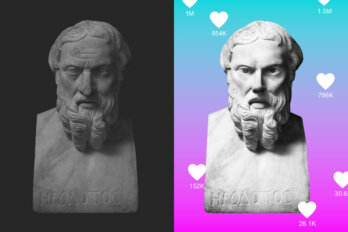In July 2020, Vili Lehdonvirta, a Finnish British economic sociologist who studies how digital technology shapes economies, was living in Tokyo, then a city with few COVID-19 restrictions but a lingering wariness of the disease. One night, a favourite artist of his began streaming a gallery show, in real time, on Instagram.
The artist, Taro Yamamoto, makes modern art grounded in Japanese tradition. His most famous piece emulates a four-hundred-year-old folding screen depicting the classical gods of wind and thunder—but replaces them with Nintendo’s Super Mario Brothers. Richly textured and made with materials such as gold leaf, which reflects light differently when seen from different angles, his artwork is hard to fully appreciate in online photos, and Yamamoto was lamenting the fact that the gallery was empty.
Lehdonvirta, who usually works from the Oxford Internet Institute, suddenly realized that he could go keep Yamamoto company: he was, after all, in the same city where the exhibition was happening. He rode the subway through the quiet megalopolis, showed up at the gallery, and spent two hours with the artist. They didn’t discuss whether live audiences would return to galleries soon, however, or how to lure them back to the physical world. Instead, Lehdonvirta told me, they talked about whether Yamamoto could take his art into the three-dimensional space of virtual reality, such as the game world of Animal Crossing, where so much more of Tokyo—and the rest of the world—was hanging out that night. The scene was quaintly surreal: two figures in living, face-to-face conversation, accepting the end of that era.
This is all potentially good news, said Lehdonvirta, who first learned to write basic code in the mid-1980s, when he was five or six years old. In virtual reality, Keynes’s “economic problem” has decisively been solved. It is a world of total abundance, in which endless novelty, passing fads, and planned obsolescence are rendered nearly harmless. “You can accelerate consumption. You can throw away stuff. The fashion cycle can go faster and faster without increasing material requirements or the environmental footprint,” Lehdonvirta said. All you’re doing when you turn one virtual garment into another is “flipping bits”—changing one kind of digital information into another.
Would we do it? Turn our backs on malls, shops, theatres, restaurants, stadiums, spas, and resorts and carry on as virtual consumers? Life in pandemic quarantine seemed to provide an answer, and it was an emphatic yes. The big-bang expansion of online activity during the pandemic has come to be known as the “digital surge.”
Vili Lehdonvirta isn’t out to abandon physical reality for the matrix. Like many Finns, he typically spends part of each year in a rustic cabin (“except the mobile connectivity is always much better even than in Oxford”). He can tell an edible mushroom from a toadstool and brings Finnish bilberries and wild game meat back to England so that he can avoid eating mass-produced food. What he pictures is a world in which much of what we do in the material economy now—telling the world who we are, exploring our identities, showing off our tastes or our skills and so on—is done through virtual consumption while real-world consumption shrinks to focus mainly on material needs.
“You can have this stable state where everyone’s got connectivity, everyone’s got a screen, everyone’s got an input method—and that’s all that’s needed for virtual consumption,” he said. “You’re going to need to supply electricity to those devices. You’re going to need to replace them when they die. But the actual growth can happen all inside of that screen.”
We can already see virtual objects in material space: augmented reality can provide us with digital sculptures, houseplants that never die, or walls that can change colours in an instant. For now, though, we can see such things only through cumbersome pairs of goggles. If we could use lightweight glasses instead—or, better yet, contact lenses—we might embrace virtual possessions as eagerly as we took to recorded and disembodied voices through technologies like radio, phonographs, and land-line telephones more than a century ago.
When we do, consumer culture will be waiting for us. “That’s the way capitalism works: you go where the people are and sell to them within that space. If that space looks like this”—Lehdonvirta’s fingers traced the rectangular frame he appeared in during our video call—“then there’s a lot that businesses can do to make this space more commercial. Not necessarily better, but more commercial.”
So far, digital consumption has shown every sign of behaving exactly like ordinary, real-world consumption. It has endlessly increased. It devours more and more resources every year. And it consistently outpaces every effort to make it green. It is more accurate, for now, to say that digital consumption is real-world consumption.
The energy-efficiency improvements in digital technology are legendary. The first computer built along the same principles we use today was called the Electronic Numerical Integrator and Computer, or ENIAC, developed by the US military in the 1940s. You certainly couldn’t go shopping for one. The machine was as long as a blue whale and as heavy as a Second World War tank. According to calculations by environmental scientist Ray Galvin, if you built a computer as smart as the typical desktop computer today but used ENIAC technology, it would weigh 5 million tonnes and, if you started building it in London, pointing west, would eventually stretch across the Atlantic Ocean and deep into Canadian wilderness. The moment you turned it on, it would devour 70 percent of the power used in the UK.
Today’s computers obviously consume energy much more efficiently and require far fewer resources to manufacture. Yet, for the past 200 years, both energy efficiency and the total consumption of energy have steadily increased, side by side.
“Energy efficiencies in the infrastructure are important,” said Kelly Widdicks, a computing researcher at Lancaster University, in England, “but they are made inconsequential by the sheer growth in demand.”
In 1992, the internet carried 100 gigabytes of data per day. By 2007, when the iPhone was released, it carried 2,000 gigabytes per second. Today, it’s moving beyond 150,000 gigabytes per second. Measured across a year, that’s nearly five zettabytes, an amount that is just as incomprehensible as it sounds. (In long form, it’s 5,000,000,000,000,000,000,000 bytes.)
In recent years, annual data consumption has grown at a compound rate of about one-quarter, and—once again in common with material consumption—the ways we consume are becoming more resource intensive rather than less. Coming in the near future is a swelling wave of data-demanding technologies, including artificial intelligence, augmented reality, virtual reality, cryptocurrencies, the smart home, self-driving cars, and the Internet of Things, which will link our internet-connected devices to one another.
We don’t yet know, really, how harmful—or not—all of this is to the planet, said Widdicks. Ironically, the data on the environmental costs of data is not great. Still, there are patterns worth paying attention to. One is a feedback loop: new digital devices and services drive higher demand for data, which requires larger and faster networks, which pushes growth in internet infrastructure, such as fibre optic cables, data centres, transmission towers, and personal devices. With the expanded infrastructure in place, the pattern repeats itself. The result is a constant increase in both the material and energy demands of the digital world.
The internet is still thought of as a cornucopia—a bottomless horn of plenty. “A lot of people don’t really think about the internet using energy,” Widdicks said. “People think more of the power consumption of charging the phone.” Meanwhile, electrical demand from digital infrastructure and our devices has been growing at about 7 percent a year globally, more than twice as fast as the rate of economic growth. Conservative estimates are that about one-fifth of global electricity will be used up by information and communications technology before the current decade is over, meaning that, in order to fight climate change, we need to produce not only enough renewable electricity to replace nearly all the energy we currently pump into our digital lives, but more and more and more in the future.
Widdicks humbly suggests an alternative approach. “We need to curtail the demand for internet connectivity.” One way to do that, curiously enough, is to stop shopping for so many material goods: overnight, the market shrinks for upgraded phones and devices, new internet-connected lights and showers and toasters and cars, and the data consumed through online shopping itself. Another part of the solution is to have fewer but better experiences online.
A few decades ago, most households shared a single TV; today, the trend is toward multiwatching, in which multiple people—or even individuals—watch different programs on different devices at the same time. Another recent practice is media multitasking: streaming video while online shopping, online shopping while checking social media, checking social media while online gaming. Then there is “trivial watching,” or viewing things that add little or nothing to our lives—not even guilty pleasure or escapism. Widdicks and nine of her colleagues once put themselves through an exercise in digitally “living with less.” For two weeks, they strived to connect to the internet only when it felt necessary to do so, turning digital consumption into something closer to a need than a want. All of them found that some of their digital consumption—streaming music at home, streaming videos while doing chores, listening to podcasts while exercising, constantly checking social media or searching miscellany on the web—could be eliminated without any inconvenience or distress, often filling the extra time with reading, cooking, chatting, creative projects, or even sleeping and bathing. “People adapt to internet disconnection,” Widdicks said.
Yet she forgives us for choosing not to abstain. Once, during a period when she was writing an article about environmentally unsustainable streaming patterns, she also streamed all sixty-two episodes of the hit TV program Breaking Bad in her spare time. “It was just so good,” she told me. “And obviously one of the drivers around video streaming is how it’s designed—in terms of autoplay video—so you watch one and the next one is automatically loading, and you’re like, Oh well, may as well keep watching.”
Our devices and digital services can be “undesigned” to help us use the internet less, Widdicks said. Instead of autoplay, for example, apps could have autoclose features or be required to allow people to choose, during set-up, maximum amounts of time they want to use them. Some streaming could be shifted to broadcast TV, which is far less energy-intensive, and we could ban all marketing that promotes digital bingeing. (“How is it that excess is valued as neutral or even positive, in this context?” Widdicks asked.) We could even choose to put limits on data demand for reasons of health or climate protection. All of these, and many other ideas for slowing digital consumption, involve the same radical redirection of society as stopping shopping: a shift away from the endless more, toward a sense of sufficiency.
Perhaps the first place we will learn sufficiency will be online. Lehdonvirta said that the sheer pace of growth and change that is possible with fully virtual consumption—the kind that takes place entirely within virtual space—could lead us to stop wanting more and more.
Already, designers of video games and other virtual realms have noticed that users don’t like to be overwhelmed with too many goods or choices. Unlike real-world economists, who focus on expanding the GDP, makers of digital worlds are mainly interested in user satisfaction and enjoyment. As a result, they tend to keep the GVP—gross virtual product—stable rather than endlessly growing. Too much of a thing makes it less special, too much novelty renders every new thing meaningless, and too much of everything stops making us happy. What happens then is that we don’t want to play the game anymore.
“The bottleneck is not going to be our ability to produce virtual goods or to destroy them when they’re no longer needed but to keep coming up with virtual goods that somehow kick off a new consumer cycle,” Lehdonvirta said. “There’s got to be some kind of a limit to consumers’ ability to adopt new fashions and trends and get excited about them—I think there must be some equilibrium. You can maybe escape the ecological limits, but I doubt that there is, even in a completely virtualized, immaterial economy, an appetite for endless growth.”
On the day the world stops shopping, we might really move consumer culture into digital space, where it can grow and accelerate until we are finally ready to let it go. A warning, though: we still may be waiting a while. The idea that consumer appetite will one day meet its natural limit, after all, is not a new one. William Stanley Jevons said the same about the material economy more than 150 years ago.
Excerpted from The Day the World Stops Shopping by J. B. MacKinnon. Copyright ©2021 J. B. MacKinnon. Published by Random House Canada, a division of Penguin Random House Canada Limited. Reproduced by arrangement with the publisher. All rights reserved.






